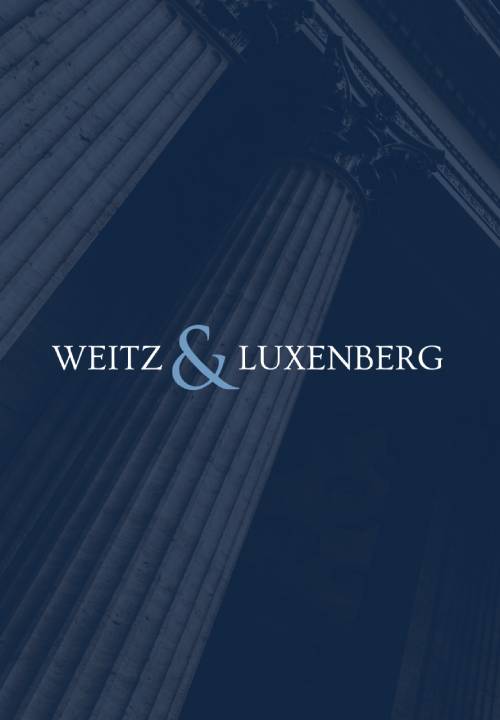Finding an Experienced Lawyer
Founded almost 40 years ago, Weitz & Luxenberg set out to help people diagnosed with mesothelioma, an aggressive cancer caused by asbestos exposure.
Since then, we have grown to become one of the largest personal injury and mass tort law firms in the New Jersey and New York areas. Our clients in New Jersey get superior representation because Weitz & Luxenberg is both local and national.
We have a strong local presence in New Jersey: we are in court frequently; we know the assigned asbestos Judge and Special Master, and they know us; we live and work in New Jersey, so we connect with local jurors.
Simultaneously, we have a strong national presence: we are the leading plaintiffs’ asbestos firm in the single best jurisdiction in the world, New York City; our outsized verdicts in NYC grant us leverage to negotiate with those same defendants in New Jersey; we are the 800-pound gorilla, and we are treated accordingly.
Mesothelioma Diagnoses and Death Rates in New Jersey
From 2015 through 2018, almost 500 New Jersey residents were diagnosed with mesothelioma.(1)
Once a person is diagnosed with mesothelioma, the survival rate is poor. Generally speaking, only about 1 in 8 people survive more than 5 years.(2)
As of 2017, the nationwide average asbestos-related death rate is 4.9 for every 100,000 people. The state average for New Jersey residents is much higher at 6.8 per 100,000. Some New Jersey counties have even more than double or triple the national average.
Diagnosed with mesothelioma? Contact us now for a free consultation and more information about your legal options.
Get a Free Case ReviewThese include Cape May, Gloucester, Salem, Ocean, Camden, and Somerset counties.(3)
Some of these same counties also have the greatest estimated number of asbestos-related deaths in New Jersey between 1999 and 2017:(4)
- Ocean County — 1,190
- Camden County — 1,113
- Somerset County — 1,057
- Bergen County — 1,053
- Middlesex County — 994
Where Can Asbestos Be Found?
Thousands of different types of commercial products contain asbestos. Some estimates place that number around 3,000.
In any homes built before 1978 in New Jersey, you may find asbestos in thermal insulation on boilers and pipes. You might also find it in any of these products:(5)
- Roofing materials.
- Attic insulation.
- Floor tiles.
- Glue attaching tiles to concrete or wood.
- Textured ceilings
- Window caulking or glazing.
- HVAC duct insulation.
- Siding material.
- Fiber cement siding
- Plaster.
For decades, manufacturers and builders have used asbestos for a variety of reasons. Asbestos occurs naturally in the environment and is relatively cheap and easy to mine. In addition, this mineral is heat and chemical resistant, insulates well, and does not corrode.
While manufacturers appreciated these qualities, they ignored the fact that asbestos is toxic. Companies that failed to warn people using their products, allowed exposure to asbestos that put those people’s lives at risk. Asbestos exposure is linked to severe lung damage and disease, including lung cancer, mesothelioma, and asbestosis.(6)
Local Verdicts & Settlements
Our New Jersey office was established in 1997. Since then, we have been able to secure financial compensation for many of our clients who were the victims of exposure to asbestos.
Our attorneys in New Jersey regularly negotiate millions of dollars in verdicts and settlements for our clients. Across the firm, Weitz & Luxenberg attorneys have negotiated settlements and verdicts totaling $17 billion.
Some of our New Jersey settlements include victories for:
- The family of an auto mechanic, mostly from exposure to brakes.
- A car mechanic, due to work exposure to gaskets, clutches, and brakes.
- The family of an auto mechanic’s wife who died from secondary exposure.
- A union carpenter diagnosed after a lifetime of asbestos exposure.
- A doctor exposed to asbestos throughout his school years.
- A woman who worked on her house and her father’s home.
- The family of a man exposed during home renovations.
- John Pilla describes how W&L treated his mother, a victim of secondary exposure.
Well-Known Contamination Sites
There are sites throughout New Jersey that are well-known for asbestos processing, usage, and exposure. Some of the worst offenders include power stations, refineries, manufacturing sites, chemical companies, and shipyards.
Power Stations
- PSE&G, Linden Station, Linden.
- AC Electric, Deepwater and Beesleys Point.
- JCP&L, South Amboy and Sayreville.
- PSE&G, Harrison and Hudson.
- Oyster Creek Nuclear Generating Station.
- Salem Nuclear Power Plant.
- Hope Creek Nuclear Generating Station.
Refineries
- Bayway Refinery, Linden.
- Humble Oil, Linden.
- Exxon Mobile, Paulsboro.
- Citgo Petroleum, Deptford.
- Texaco, West Deptford.
- Delmarva, Pennsville.
Manufacturing Sites
- Johns-Manville, Manville.
- Campbell Soup Company, Camden.
- American Steel, Trenton.
- Owens Corning Fiberglas, Berlin.
- CE Glass, Pennsauken.
- Kimble Glass.
- DuPont, Pennsville.
- Weyerhaeuser Paper Mill, Delair.
Chemical Companies
- Hooker Chemical, Burlington.
- Allied Chemical.
- Barrett Chemical.
- Harshaw Chemical, Gloucester.
- JT Baker Chemical, Philipsburg.
- Thiokol Chemical, Trenton.
- American Cyanamid, Bound Brook.
Shipyards
- NY Shipbuilding Corporation (NY Ship), Camden.
Hospitals
- New Jersey State Hospital, Trenton.
- Princeton Hospital, Princeton.
Universities/Colleges
- Rider University, Lawrenceville.
- Princeton University, Princeton.
- Rutgers University, New Brunswick.

Chapter 11 Bankruptcy Trusts
To stay afloat, companies may file for Chapter 11 Bankruptcy. Once in bankruptcy, the company must set aside money in a trust to compensate asbestos victims before it is allowed to reorganize and go back into business.(7)
Since 2000, asbestos personal injury trusts have played an increasingly significant role in compensating victims of asbestos-related injuries. These trusts, rather than the reorganized company, oversee the payment of compensation to victims who have filed asbestos-exposure claims. Although, there are billions of dollars in the trusts, the amount of compensation to each individual is significantly less than they may have been able to obtain if the company had not declared bankruptcy.(8)
Asbestos Regulations
Today, the U.S. Environmental Protection Agency (EPA) and the Occupational Safety and Health Administration (OSHA) oversee federal regulations regarding asbestos both in and out of the workplace. Each state, including New Jersey, also has its own regulations.(9) (10) (11)
Meet the W&L Mesothelioma Lawyers in New Jersey
Weitz & Luxenberg was founded to help people diagnosed with asbestos-related illnesses. Among our nearly 100 attorneys across the country, we have designated a specialized team of approximately 15 New Jersey mesothelioma lawyers who primarily handle these types of cases.
Our New Jersey team is based out of our office in Cherry Hill. If you become one of our clients, a W&L lawyer in N.J. will work with you personally. We’d like you to meet a few of our experienced attorneys:
Jerry Kristal, Partner

Most of the cases in which he plays an active role are those involving either asbestos exposures (mesothelioma, lung cancer, asbestosis) or injuries caused by dangerous pharmaceuticals and medical devices — with regard to the former, some of the verdicts he has obtained are among the highest ever brought in against U.S. asbestos defendants.
Leonard F. Feldman, Associate Attorney

Leonard F. Feldman runs our asbestos litigations in Pennsylvania and New Jersey from our offices in Cherry Hill, N.J.
F. Alexander Eiden, Associate Attorney

F. Alexander Eiden is an attorney in our Asbestos Litigation group.
Mary Grabish Gaffney, Associate Attorney

Mary Grabish Gaffney concentrates on representing clients suffering asbestos-related illnesses as well as those alleging other forms of personal-injury harm.
Lawyers Who Know Local New Jersey Asbestos Laws
If you live in New Jersey and have been diagnosed with mesothelioma, you may want to contact a local mesothelioma lawyer. Although every state is expected to follow federal asbestos regulations, individual states also have their own.
New Jersey mesothelioma lawyers specialize in local laws and regulations regarding asbestos. The advantage to working with someone locally is that he or she knows not only the federal laws and regulations but also any statutes specific to New Jersey.
